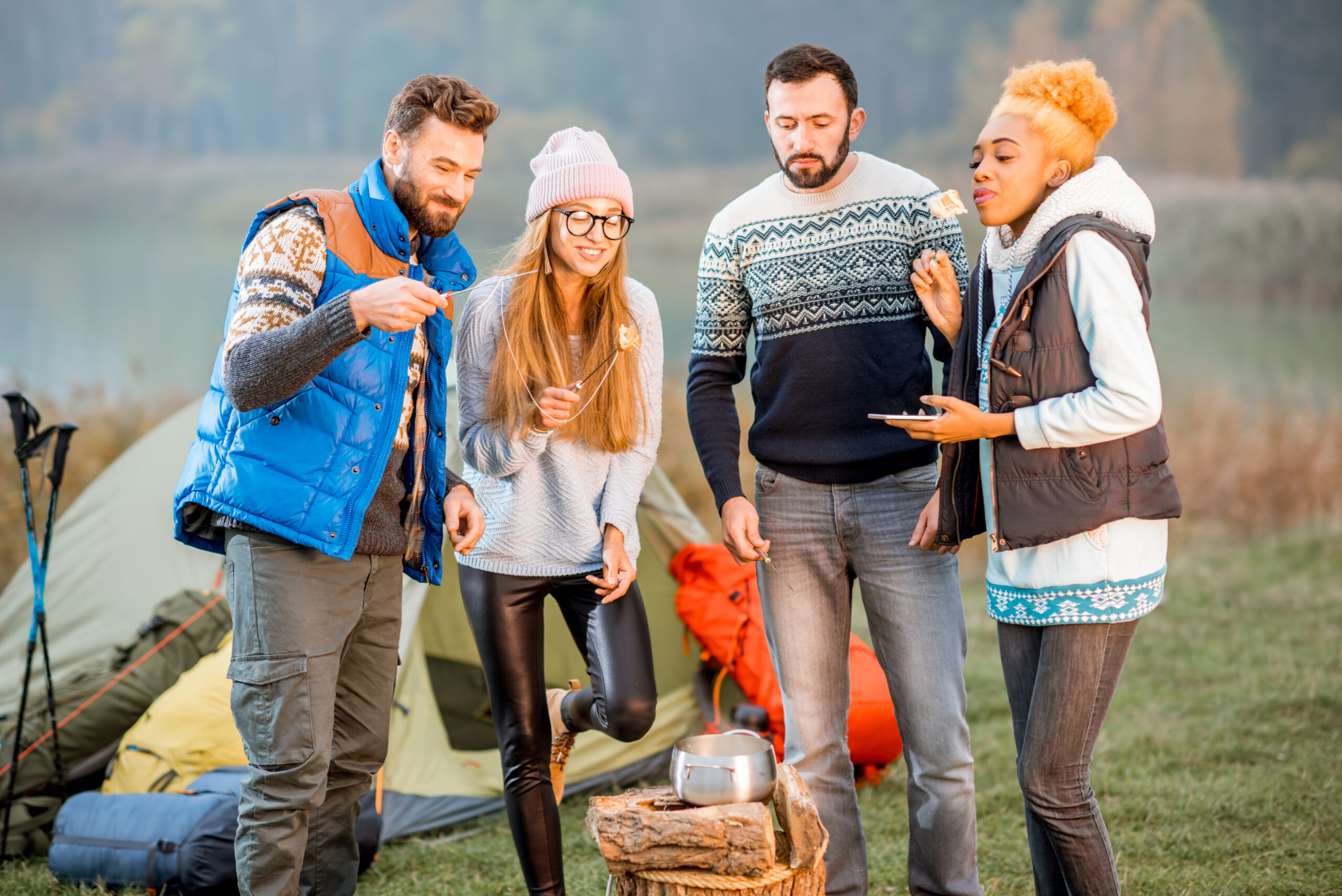This blog post may contain affiliate links. As an Amazon Associate I earn from qualifying purchases.
Camping lets you connect with nature and enjoy the great outdoors. But the great outdoors brings its own set of problems, heat, rain, wind, and snow to name but a few. This is why choosing what to wear when camping is just as important as choosing what gear to pack or which tent to bring. The right clothing can be the difference between an enjoyable camping trip and a miserable one.
In this guide, I want to go over the clothing choices I would make for different camping environments, as well as some tips around layering and fabric choices which I’ve picked up over my decades of camping experience.
Also Read: Essential Tent Camping Gear Checklist
Clothing Basics for Camping

Before we start talking about which clothes are right for which season, let’s look at some camping clothes basics. These are fundamental tips that apply no matter what environment you are camping in.
- Layering
Layering your clothes is one of the best tools you have for regulating your temperature while camping. By removing or adding layers of clothing as needed, you can maintain a comfortable body temperature. Start with a moisture-wicking base layer to keep sweat away from your skin. Then add insulating layers like fleece or down to help keep you warm. Finally, add a waterproof and windproof outer layer to protect against the elements. - Footwear
Good quality, appropriate footwear is crucial. Especially if you’re combining your camping with a hike. Leave your sneakers at home and get a pair of high-quality hiking boots with adequate ankle support. You should also make sure your boots are worn in BEFORE you go camping to prevent your feet from developing blisters. Don’t go for the cheapest pair as a good quality set of hiking boots will last you for years. - Headgear
Protecting your head is important and your choice of headgear can have a big effect on how your body regulates its temperature. A wide-brimmed hat is a great choice for hot climates and a beanie is a great choice for cold climates. If you plan on doing any climbing while you are away, you should also pack a helmet. - Accessories
Gloves, scarves, and sunglasses are all excellent accessories to pack. They can enhance your camping experience and allow you to protect your eyes and extremities from extreme hot or cold.
What to Wear When Camping in the Summer?
Your main concern when camping in the summer should be keeping cool and avoiding heat stroke. Consider packing the following;
- Lightweight Clothing
Wear lightweight and breathable materials like moisture-wicking shirts and shorts. Long-sleeved shirts can also protect your arms against sunburn. - Sun Protection
Sunglasses, a wide-brimmed hat, and suncream (yes, I know it’s not technically clothing!) are all essential. Some clothing has a UPF rating (Ultraviolet Protection Factor) for added protection from sunlight and can be a good choice if you are going to be spending a lot of time in the sun. - Proper Footwear
Comfortable hiking boots are a must-have. If your camping plans are more leisurely, you might want to invest in some hiking sandals instead (just make sure they provide adequate support and ventilation.)
Read Also: 4 Best Canopy Tent for Vendors 2025
What to Wear Camping in the Winter?

When camping in the winter, your main concern should be keeping warm and preventing hypothermia and frostbite.
- Insulating Layers
Pack several layers of warm clothing like down or synthetic jackets. These trap heat and help you keep warm. You can always remove layers if you need to so pack slightly more than you think you will need. - Thermal Underwear
Thermal underwear is a great purchase. Merino wool is my favorite, but synthetic options work well too and are much less expensive. - Warm Footwear
Thermal socks are a great addition. I often find my feet can get very cold at night, and it stops me getting to sleep. Thermal socks help lock heat in. My hiking boots are also insulated, which helps keep me warm while I’m trekking about in the snow. - Gloves and Accessories
Thick, insulated gloves, a neck gaiter, and a beanie are all crucial things to pack to keep your extremities warm in cold weather. - Snow Gaiters
If you are going to be hiking in heavy snow, snow gaiters can help keep snow out of your boots and pants.
What to Wear Camping in Spring or Fall?
Fall and Spring are very variable seasons. The temperature can swing from near freezing to pleasantly warm, sometimes within the same day! This is why it’s important to be prepared for all eventualities.
- Layer for Temperature Swings
Be prepared for cool mornings but mild to hot afternoons. Layer your clothing so that you can easily remove items as the temperature increases. A fleece jacket and lightweight down vest is my go-to combination. - Rain Gear
A waterproof jacket and pants are a must, as the chance of rain is high in fall and spring. I also like to keep one of those rainproof ponchos in my bag that I can put on if it really starts pouring down. - Durable Footwear
Conditions can get very muddy and wet, so sturdy waterproof hiking boots are crucial. Remember to brush as much mud off your clothes as possible before getting back in your tent. - Hat and Gloves
Don’t forget to pack a warm beanie and insulated gloves for those chilly evenings.
Final Thoughts – How To Dress Warm While Camping
The right choice of clothing can be the difference between a fun camping experience and a miserable one. Hopefully, you now have a better understanding of which clothing is necessary for each season.
Next time you are going camping, make sure that you have carefully considered the location you are camping, and the weather forecast and plan accordingly. With just a little forethought and preparation, you can make your camping trip a lot more pleasant. Happy camping!
FAQs
What kind of clothing should I bring for a summer camping trip?
For summer camping, focus on lightweight, breathable materials like moisture-wicking shirts and shorts to stay cool and avoid overheating. Long-sleeve shirts can help protect against sunburn and don’t forget essential sun protection like sunglasses, a wide-brimmed hat, and sunscreen. Sturdy, comfortable footwear like hiking boots or ventilated hiking sandals is also key.
How should I layer clothing for cold-weather camping?
Layering is essential for cold-weather camping to maintain warmth. Start with a moisture-wicking base layer, add insulating layers like fleece or down, and top with a windproof, waterproof jacket. Thermal socks, gloves, a beanie, and accessories like a neck gaiter will help keep extremities warm. Consider thermal underwear for extra insulation.
What are the best fabrics for camping clothing?
Choose fabrics based on the season and weather. Moisture-wicking synthetics or merino wool make excellent base layers as they help regulate temperature and prevent sweat buildup. For insulation, fleece or down layers work well, and waterproof jackets made from Gore-Tex or similar materials are ideal for outer layers in wet or windy conditions.
Do I need different footwear for camping in different seasons?
Yes, footwear is an essential consideration. In warmer months, breathable hiking boots or supportive hiking sandals are ideal. For colder seasons, choose insulated, waterproof hiking boots to keep your feet warm and dry. Snow gaiters are recommended for snowy conditions to keep snow out of your boots and pants.


